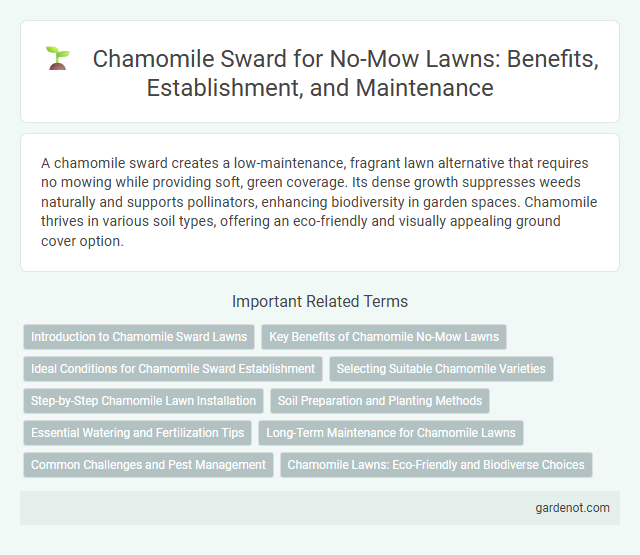A chamomile sward creates a low-maintenance, fragrant lawn alternative that requires no mowing while providing soft, green coverage. Its dense growth suppresses weeds naturally and supports pollinators, enhancing biodiversity in garden spaces. Chamomile thrives in various soil types, offering an eco-friendly and visually appealing ground cover option.
Introduction to Chamomile Sward Lawns
Chamomile sward lawns offer a low-maintenance, fragrant alternative to traditional grass, thriving without regular mowing due to their dense, ground-covering growth. This hardy herbaceous plant forms a soft, drought-tolerant carpet with small white flowers, enhancing biodiversity and supporting pollinators. Ideal for eco-friendly landscaping, chamomile sward reduces water use and lawn care costs while providing year-round greenery.
Key Benefits of Chamomile No-Mow Lawns
Chamomile no-mow lawns provide a fragrant, low-maintenance ground cover that thrives without frequent mowing, conserving time and energy. Their dense, evergreen foliage promotes soil health by reducing erosion and supporting beneficial insects, enhancing garden biodiversity. The natural pest-repellent properties of chamomile help protect nearby plants, making it an eco-friendly choice for sustainable landscaping.
Ideal Conditions for Chamomile Sward Establishment
Chamomile sward thrives best in well-drained, sandy loam soils with a pH range of 6.0 to 7.5, ensuring optimal root development and nutrient uptake. It requires full sun exposure and moderate moisture levels, avoiding waterlogged conditions that can lead to root rot. Establishment success increases when seeds are sown in early spring or late summer, taking advantage of mild temperatures between 15degC and 25degC for vigorous germination and growth.
Selecting Suitable Chamomile Varieties
Choosing chamomile varieties for a no-mow lawn requires focusing on low-growing, drought-tolerant types such as Roman chamomile (Chamaemelum nobile) and German chamomile (Matricaria chamomilla). Roman chamomile is preferred for its dense, fragrant sward and ability to withstand foot traffic, making it ideal for ground cover. Selecting cultivars with compact growth and high resilience ensures a sustainable, low-maintenance no-mow lawn rich in biodiversity and visual appeal.
Step-by-Step Chamomile Lawn Installation
Prepare the soil by removing existing grass and weeds, then loosen the top 4-6 inches to create an ideal seedbed for chamomile sowing. Distribute chamomile seeds evenly across the prepared area at a rate of about 4-6 ounces per 1,000 square feet, lightly raking them into the soil to ensure good seed-to-soil contact. Water the lawn gently but consistently to maintain moisture until the seeds germinate, which usually occurs within 7-14 days, promoting a dense, fragrant chamomile sward ideal for a no-mow lawn.
Soil Preparation and Planting Methods
Chamomile swards thrive in well-drained, sandy or loamy soils with a pH between 6.0 and 7.5, requiring thorough soil preparation including tilling and removal of weeds to ensure optimal root development. Plant seeds in early spring or late fall, sowing them shallowly at a depth of 0.1 to 0.25 inches, either by broadcasting or using a no-till drill seeder for even distribution. Maintaining consistent moisture during germination, typically 7 to 14 days, supports vigorous growth and establishes a dense, low-maintenance no-mow lawn alternative.
Essential Watering and Fertilization Tips
Chamomile sward requires minimal watering, with deep irrigation recommended only during prolonged dry spells to maintain soil moisture without causing root rot. Fertilization should be light and infrequent, using balanced organic compost or a slow-release fertilizer applied in early spring to promote healthy growth and blooming. Over-fertilization can lead to excessive foliage and reduced flower production, so monitoring nutrient levels is essential for a thriving no-mow chamomile lawn.
Long-Term Maintenance for Chamomile Lawns
Long-term maintenance of chamomile swards involves minimal mowing, as frequent cutting can damage the delicate flowers and reduce their spread. Allowing chamomile lawns to grow naturally promotes deeper root systems, enhancing drought resistance and soil health over time. Periodic light trimming in early spring encourages fresh growth while preserving the lawn's natural, fragrant appearance.
Common Challenges and Pest Management
Chamomile sward in no-mow lawns often faces challenges such as patchy growth, weed invasion, and susceptibility to fungal diseases like powdery mildew. Effective pest management includes monitoring for aphids and spider mites, which can damage the delicate foliage, and introducing natural predators like ladybugs to control infestations. Maintaining optimal soil moisture and avoiding excessive nitrogen fertilization help reduce stress and disease vulnerability in chamomile turf.
Chamomile Lawns: Eco-Friendly and Biodiverse Choices
Chamomile lawns offer an eco-friendly alternative to traditional turfgrass by promoting biodiversity and reducing chemical use. These swards attract pollinators like bees and butterflies, enhancing local ecosystems while requiring minimal mowing and water. Integrating chamomile into lawns supports sustainable landscaping practices and creates a fragrant, resilient ground cover.
Chamomile sward Infographic

 gardenot.com
gardenot.com